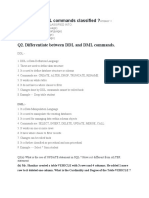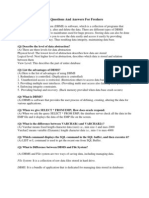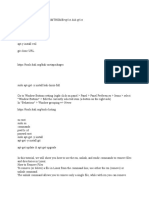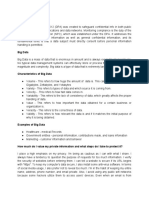Database Assignment
Database Assignment
Uploaded by
bhanumathy91Copyright:
Available Formats
Database Assignment
Database Assignment
Uploaded by
bhanumathy91Original Description:
Original Title
Copyright
Available Formats
Share this document
Did you find this document useful?
Is this content inappropriate?
Copyright:
Available Formats
Database Assignment
Database Assignment
Uploaded by
bhanumathy91Copyright:
Available Formats
DATABASE ASSIGNMENT
Question 1: Provide the create table syntax to Create a Table Employee whose details are as below. Employee(EmployeeID, LastName, FirstName, Address, DateHired) Answer1: create table Employee( EmployeeIDint(6) primary key,LastNamevarchar(20),FirstNamevarchar(20),Address varchar2(50),date date ); Question 2: Provide the INSERT query to be used in Employee Table to fill the Details. Answer2: Insert into Employee values (100,'gourav','kishan','hyderabad', date); Question 3: When we give SELECT * FROM EMPLOYEE .How does it Respond? Answer3: When we type the following query of select * from employee it returns all the data present that is all the columns in employee table. In this case it shows the above values in the insert statement. Question 4: Create a Table CLIENT whose details are as below. Client (ClientID, LastName, FirstName, Balance, EmployeeID) Answer4: create table Client(ClientIDint(6), LastNamevarchar(20), FirstNamevarchar(20), Balance float(10) , EmployeeID foreign key references Employee(EmployeeID)); NOTE: INCASE IF WE USE BOTH EMP AND CLIENT TABLE IN 1 DB..OR HAS A RELATION FOREIGN KEY OR NOT NULL AND REFERENCES ARE REQUIRED ELSE NO NEEDED. Question 5: Provide the INSERT query to be used in CLIENT Table to fill the Details. Answer5: INSERT INTO Client(ClientID,LastName,FirstName,Address, EmployeeId) Values (value1,value2,value3,value4 ); We can also use dynamic way to insert values into the table using the '&' operation EX ('&&value2' and so on ...) Question 6: When we give SELECT * FROM CLIENT .How does it Respond? Answer6: It returns all the rows and columns present in the client table .that are it shows all the field data of client table. Question 7: Choose the correct answer. The SQL command to create a table is: a. Make Table b. Alter Table c. Define Table d. Create Table
Answer7: d Question 8: Choose the correct answer. The DROP TABLE statement: a. deletes the table structure only b. deletes the table structure along with the table data c. works whether or not referential integrity constraints would be violated d. is not an SQL statement Answer8: b Question 9: What are the different data types available in SQL server? Answer9: : 1) Numeric : Stores numeric values. 2) Monetary : It stores numeric values with decimal places. It is used specially for currency values. 3) Date and Time : It stores date and time information. 4) Character : It supports character based values of varying lengths. 5) Binary : It stores data in strict binary (0 or 1) representation. 6) Special purpose: SQL Server contains Complex data types to handle the XML Documents,Globally unique identifiers etc. Question 10: Which is the subset of SQL commands used to manipulate Oracle Database structures, including tables? Answer10: DDL( Data Deifinition Language).
Question 11: What operator performs pattern matching? Answer11: LIKE Operator.
Question 12: What operator tests column for the absence of data? Answer12: IS NULL Operator. Question 13: Which command executes the contents of a specified file? Answer13: START or @ command. Question 14: What is the parameter substitution symbol used with INSERT INTO command? Answer14: '&' commonly known as ampersand operator. Question 15: Which command displays the SQL command in the SQL buffer, and then executes it? Answer15: RUN. Question 16: What are the wildcards used for pattern matching? Answer16: _ and % _ = single character substitution . % = multiple character substitution. Question 17: State whether true or false. EXISTS, SOME, ANY are operators in SQL. Answer17: TRUE. Question 18: State whether true or false. !=, <>, ^= all denote the same operation. Answer18: TRUE. Question 19: What are the privileges that can be granted on a table by a user to others? Answer19: Insert, update, delete, select, references, index, execute, alter, all Question 20: What command is used to get back the privileges offered by the GRANT command? Answer20: REVOKE.
Question 21: Which system tables contain information on privileges granted and privileges obtained? Answer21 USER_TAB_PRIVS_MADE, USER_TAB_PRIVS_RECD .
Question 22: Which system table contains information on constraints on all the tables created? Answer22: USER_CONSTRAINTS. Question 23: What is the difference between TRUNCATE and DELETE commands? Answer23: 1.Delete is a DML command and Truncate is a DDL command. 2. Where clause can be used with delete only. 3. THE Delete operation can be rolled back, Truncate operation cant be rolled back again that is it is a permanent delete. Question 24: What command is used to create a table by copying the structure of another table? Answer24: CREATE TABLE .. AS SELECT command To copy only the structure, the WHERE clause of the SELECT command should contain a FALSE statement as in the following. CREATE TABLE NEWTABLE AS SELECT * FROM EXISTINGTABLE WHERE 1=2; If the WHERE condition is true, then all the rows or rows satisfying the condition will be copied to the new table.
You might also like
- Database Programming With SQL Final ExamDocument31 pagesDatabase Programming With SQL Final ExamJosé Obeniel LópezNo ratings yet
- SQL InterviewDocument16 pagesSQL Interviewvinay reddyNo ratings yet
- SQL Test PaperDocument5 pagesSQL Test PaperSreekanth KeesaraNo ratings yet
- ISM-Practical File-BBA 212Document20 pagesISM-Practical File-BBA 212chandniNo ratings yet
- One PetroDocument11 pagesOne Petromoonrock1No ratings yet
- Air Force Reserve UTAPS GuideDocument43 pagesAir Force Reserve UTAPS GuideJohn D Foxtrot0% (1)
- Database AssignmentDocument5 pagesDatabase AssignmentAarti MakhijaniNo ratings yet
- TCS SolutionsDocument4 pagesTCS SolutionsIsha Chaudhary100% (1)
- TCS ASPIRE Assignments On Database, JAVA, UNIX With SolutionsDocument4 pagesTCS ASPIRE Assignments On Database, JAVA, UNIX With Solutionsmeenu_sharma060% (2)
- Tcs Ilp Dbms and SQL Assg1Document5 pagesTcs Ilp Dbms and SQL Assg1samcse2723No ratings yet
- DBMS & SQL Assignment 1Document5 pagesDBMS & SQL Assignment 1Madhuri PatelNo ratings yet
- Data Base ConceptsDocument3 pagesData Base ConceptsBrijesh KumarNo ratings yet
- Dbms SQL AssignmentDocument6 pagesDbms SQL Assignmentbajwa_gemNo ratings yet
- SQL Query Interview Questions and AnswersDocument14 pagesSQL Query Interview Questions and AnswersRaghu GowdaNo ratings yet
- Day PI QuestionsDocument9 pagesDay PI QuestionsVIKAS KUMARNo ratings yet
- Dbms Lab ProcedureDocument17 pagesDbms Lab ProcedureMahi 2183No ratings yet
- SQ L Worksheet 24Document35 pagesSQ L Worksheet 24Purnima ENo ratings yet
- SQL Questions 2Document23 pagesSQL Questions 2Sanjoy Guha ThakurtaNo ratings yet
- sql1Document18 pagessql1elamrajNo ratings yet
- MySql Revision TourDocument11 pagesMySql Revision TourHarshit DixitNMNo ratings yet
- SQL Server and ASP Net Questions & AnswersDocument12 pagesSQL Server and ASP Net Questions & Answersashishgaur84No ratings yet
- Interview SQLDocument22 pagesInterview SQLSandeep GantaNo ratings yet
- Dbms Full AssignmentDocument19 pagesDbms Full Assignmentsayanvk290No ratings yet
- Best SQL Interview QuestionsDocument17 pagesBest SQL Interview QuestionsSaravanan MuruganNo ratings yet
- MySql QDocument29 pagesMySql Qsuraj kumarNo ratings yet
- Some Other Links That May Help You! Make Sure To Check If The Answer Is Right!Document16 pagesSome Other Links That May Help You! Make Sure To Check If The Answer Is Right!GilangMaulanaNo ratings yet
- Model Paper 4Document14 pagesModel Paper 4Kungu Teddy NjorogeNo ratings yet
- Database Lab 5Document14 pagesDatabase Lab 5Mydah NasirNo ratings yet
- Database System: Lab Practical Week #1Document20 pagesDatabase System: Lab Practical Week #1Muhammad BilalNo ratings yet
- SQL Interview Questions and Answers GDocument67 pagesSQL Interview Questions and Answers GnageshNo ratings yet
- ISM-AYUSH BANSAL Practical file-BBA 212Document20 pagesISM-AYUSH BANSAL Practical file-BBA 212Nimish BansalNo ratings yet
- SQL Interview Questions - AnswersDocument14 pagesSQL Interview Questions - AnswersDhinesh Kumar SrinivasanNo ratings yet
- SQL, The Structured Query LanguageDocument60 pagesSQL, The Structured Query LanguagerashmiNo ratings yet
- Dbms Lab NewDocument71 pagesDbms Lab NewTHIRUMALAXEROX INTERNETNo ratings yet
- SQL Final PaperDocument7 pagesSQL Final PaperVam KeeNo ratings yet
- DBMS Part 2Document16 pagesDBMS Part 2Ann RobyNo ratings yet
- Worksheet Week4Document6 pagesWorksheet Week4himansipowersNo ratings yet
- Class 12 Ip Mysql Revision Tour Notes SolutionsDocument0 pagesClass 12 Ip Mysql Revision Tour Notes Solutionsidigiti50% (12)
- Relational Database 89 118Document30 pagesRelational Database 89 118Harshini BabyNo ratings yet
- Questions (SQL) : Saved To The Database. DCLDocument15 pagesQuestions (SQL) : Saved To The Database. DCLrutvikpatel62001No ratings yet
- Reference Practicle File For RDBMS-IIDocument41 pagesReference Practicle File For RDBMS-IIkingsofleon18200% (1)
- 2 3markDocument6 pages2 3markNasla AbdulsalamNo ratings yet
- 5 SQL86 DDL Data Manipulation Commit GrantDocument14 pages5 SQL86 DDL Data Manipulation Commit GrantHosni HchNo ratings yet
- DBWorksheet UpdateDocument34 pagesDBWorksheet UpdateLara AbuDayehNo ratings yet
- SQL Loop PDFDocument9 pagesSQL Loop PDFsrinivaskrishna235No ratings yet
- Best SQL Interview Questions & Answers: Question #1) What Is SQL?Document15 pagesBest SQL Interview Questions & Answers: Question #1) What Is SQL?Rambabu GiduturiNo ratings yet
- My SQL CommandsDocument14 pagesMy SQL CommandsSHASHANK RAJPUTNo ratings yet
- Basic DBMS Interview Questions and Answers For FreshersDocument90 pagesBasic DBMS Interview Questions and Answers For FreshersSaikiran RaghuNo ratings yet
- Assignment#3Document6 pagesAssignment#3Prateek ChandraNo ratings yet
- HomeWork 133125398572181141Document14 pagesHomeWork 133125398572181141Urvashi RaoNo ratings yet
- DBMS Lab ReportDocument19 pagesDBMS Lab Reportsamyam.wagle.22No ratings yet
- DBMS Manual Final PDFDocument49 pagesDBMS Manual Final PDFanithakannan2209No ratings yet
- Answer:: Question 1. Explain What Is A Database?Document16 pagesAnswer:: Question 1. Explain What Is A Database?vikrantNo ratings yet
- Oracle SQL Interview QuestionsDocument7 pagesOracle SQL Interview QuestionsKishor TamaskarNo ratings yet
- Solution Worksheet SQLDocument14 pagesSolution Worksheet SQLAnirudh MohantyNo ratings yet
- Worksheet With Solution SQL (Cs & Ip)Document66 pagesWorksheet With Solution SQL (Cs & Ip)epichero676No ratings yet
- Cassandra Query Language by Examples - Puzzles with AnswersFrom EverandCassandra Query Language by Examples - Puzzles with AnswersNo ratings yet
- MySQL Crash Course: A Hands-on Introduction to Database DevelopmentFrom EverandMySQL Crash Course: A Hands-on Introduction to Database DevelopmentNo ratings yet
- DB2 11.1 for LUW: SQL Basic Training for Application DevelopersFrom EverandDB2 11.1 for LUW: SQL Basic Training for Application DevelopersNo ratings yet
- Introductory Relational Database Design for Business, with Microsoft AccessFrom EverandIntroductory Relational Database Design for Business, with Microsoft AccessNo ratings yet
- Unit 1-MCQ-DVDocument5 pagesUnit 1-MCQ-DVLovely Naveen NSKNo ratings yet
- Multiple Spanning Tree Protocol (MSTP) Part-1Document8 pagesMultiple Spanning Tree Protocol (MSTP) Part-1jdwhite9No ratings yet
- MCA Synopsis MCS-044Document92 pagesMCA Synopsis MCS-044BK Ravi Kumar43% (7)
- FEWSDOC Configuration GuideDocument839 pagesFEWSDOC Configuration GuideQuique Ortiz AndresNo ratings yet
- Chapter 3 IT at WorkDocument19 pagesChapter 3 IT at WorkfarisNo ratings yet
- Weka (20030421-Version1 by Kdelab)Document51 pagesWeka (20030421-Version1 by Kdelab)tnhan78No ratings yet
- Difference Between P3 and P6Document1 pageDifference Between P3 and P6dinesh rNo ratings yet
- CS8492-DBMS SyllabusDocument2 pagesCS8492-DBMS SyllabusAkash A 202 ANo ratings yet
- Forcepoint User ID TroubleshootingDocument7 pagesForcepoint User ID TroubleshootingomarptcNo ratings yet
- Linux Cheat SheetDocument4 pagesLinux Cheat Sheetneohelix filonNo ratings yet
- Diff Betwn SAP GRC AC 10 and AC 10.1Document13 pagesDiff Betwn SAP GRC AC 10 and AC 10.1Anonymous dQ6ohSOLRNo ratings yet
- SQL-2 SelectDocument24 pagesSQL-2 SelectAbdul RehmanNo ratings yet
- MorphoManager 15.4.3Document5 pagesMorphoManager 15.4.3camilo angelNo ratings yet
- OpenSAP Byd4 Week 5 Unit 5 Additional ExerciseDocument2 pagesOpenSAP Byd4 Week 5 Unit 5 Additional ExerciseHong YangNo ratings yet
- Lab Assignment 2Document6 pagesLab Assignment 2DeleterNo ratings yet
- Big Data AssignmentDocument2 pagesBig Data AssignmentAngel MerilloNo ratings yet
- Zypper Cheat Sheet 2 LetterDocument1 pageZypper Cheat Sheet 2 LetterManivannan PandiNo ratings yet
- Database Management System (DBMS) Lab ReportDocument48 pagesDatabase Management System (DBMS) Lab ReportAnurag Bhattarai100% (1)
- Supply Chain and LogisticsDocument15 pagesSupply Chain and LogisticsANDRES ESTEBAN BECERRA VILLAMILNo ratings yet
- DBMS2Document54 pagesDBMS2SwaggerChicNo ratings yet
- Tivoli: OMEGAMON XE For Mainframe NetworksDocument220 pagesTivoli: OMEGAMON XE For Mainframe NetworksJOE SCHOLTZNo ratings yet
- Rmohrbacher 11-2015Document3 pagesRmohrbacher 11-2015api-338032428No ratings yet
- Dhamm Nis ProjectDocument6 pagesDhamm Nis ProjectHrx XNo ratings yet
- MIS442 Section 02 Group-Elite-1Document18 pagesMIS442 Section 02 Group-Elite-1Avijit Kumar SahaNo ratings yet
- Sol 2.2.8 Install Guide - Plus LinksDocument20 pagesSol 2.2.8 Install Guide - Plus LinksAlexandre BACNo ratings yet
- Fortinet SOC SolutionDocument37 pagesFortinet SOC SolutionNguyen TrungNo ratings yet
- Exam Az 500 Microsoft Azure Security TechnologiesDocument7 pagesExam Az 500 Microsoft Azure Security TechnologiesjeanpoloNo ratings yet
- Note - 0001846880 - How To Add A New Server Intelligence Agent SIA To Existing CentralManagementServer CMS For BI 4.0 4.1 On Linux Unix AIXDocument4 pagesNote - 0001846880 - How To Add A New Server Intelligence Agent SIA To Existing CentralManagementServer CMS For BI 4.0 4.1 On Linux Unix AIXfermi666No ratings yet

























































































